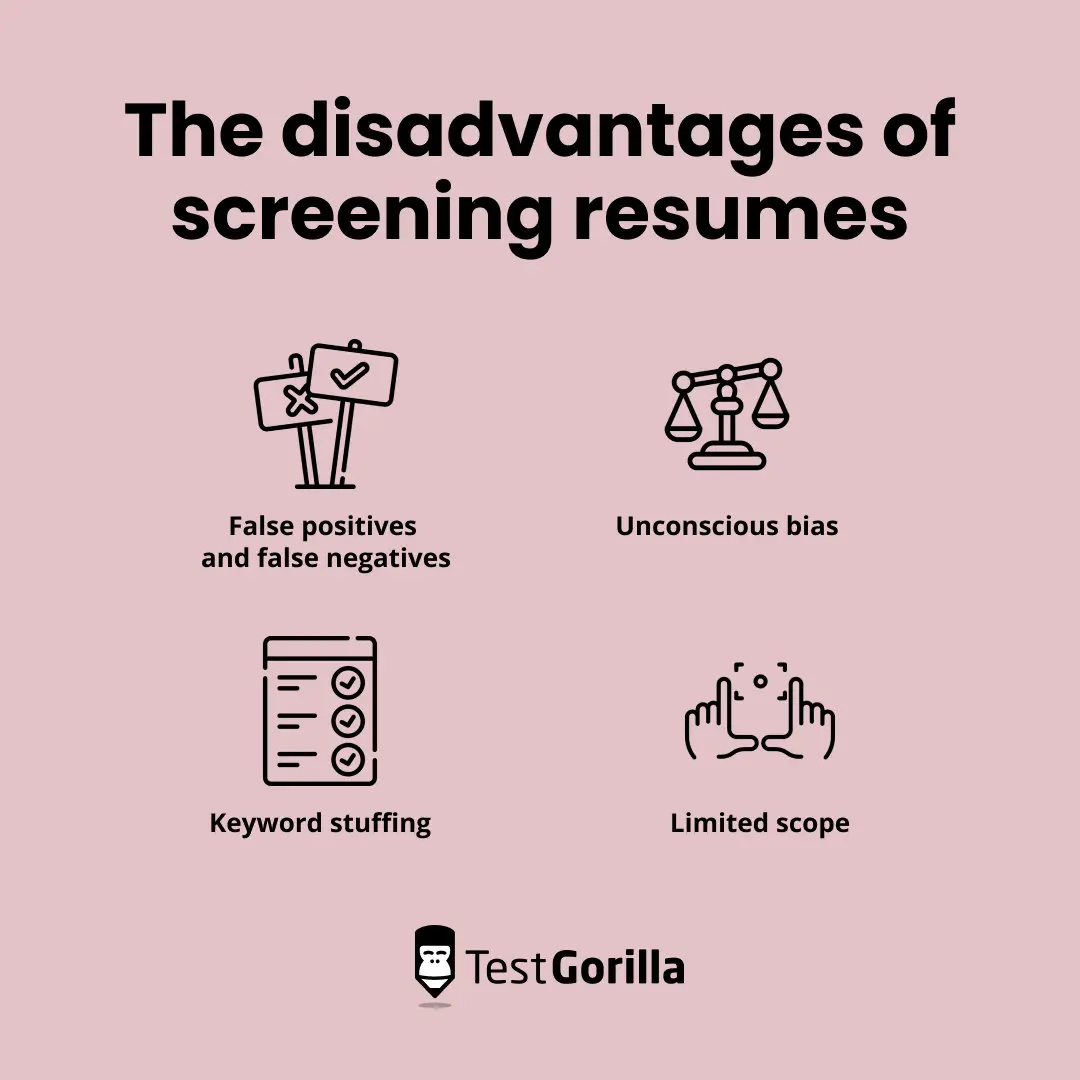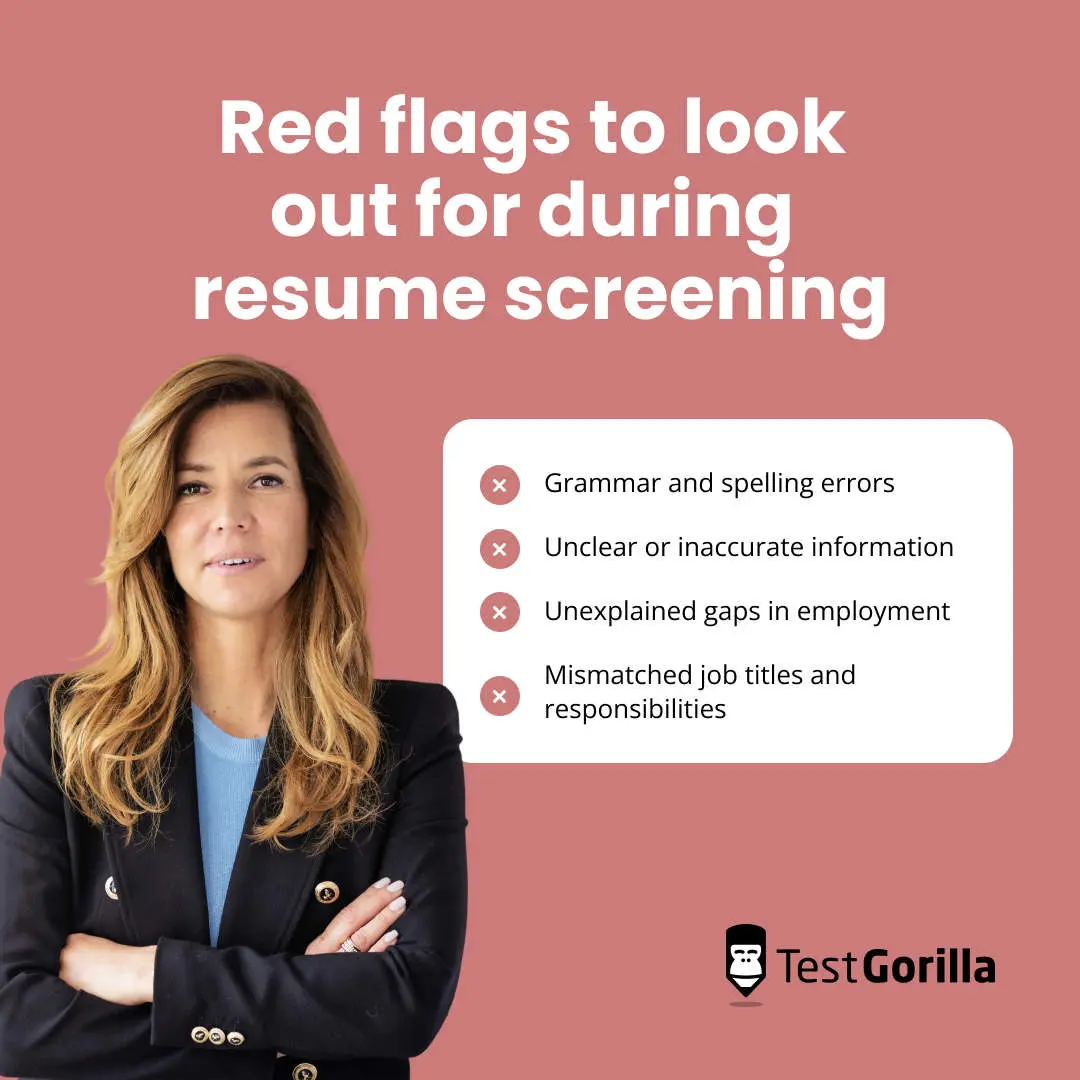Resume screening can feel daunting.
For instance, with the average corporate job opening receiving roughly 250 applications, resume screening can be a highly time-consuming process. As a hiring manager, you often have hundreds of resumes to sift through for just one open position – both from unqualified applicants and applicants who could be a great fit for the role.
So how do you ensure you're making the right hiring decisions? How do you separate good hires from poor fits? And what reliable criteria should you use for deciding who does and who doesn't get invited to the interview process?
This resume screening guide answers these questions and is packed with valuable information to help ensure that you don't mistakenly miss out on great talent. You'll also learn how to speed up the resume screening process.
But first things first.
Table of contents
- What is resume screening?
- Manual resume screening vs automated resume screening
- Importance of having a clear-cut resume screening process
- The disadvantages of screening resumes
- What to look for in resumes when you're screening manually
- How to screen resumes and make the hiring process more efficient
- Red flags to look out for during resume screening
- Enhance your resume screening process with online skills assessments
What is resume screening?
Resume screening is the process of assessing and evaluating whether a job candidate has the qualifications, desired skills, education, personality traits, and work history for a specific role based on their resume. The resume screening process usually happens after a job listing has been posted and comes before an interview.
For recruiting teams who often receive a large number of resumes, resume screening may feel like finding the best needles in the haystack of job applications.
Manual resume screening vs automated resume screening
Manual resume screening involves recruiters or hiring managers reviewing each resume individually. This approach is a time-consuming process, but it allows recruiters to assess the full scope of each candidate's qualifications and experience.
On the other hand, automated resume screening typically uses a resume screening tool. For example, an applicant tracking system(ATS) scans resumes for keywords and criteria relevant to the job opening. This process is much faster than manual resume screening, but it can also be less accurate.
Both automated screening and manual screening have their own pros and cons. The best approach for your company will depend on your specific needs and resources.
If you have a high volume of resumes to screen, then automated resume screening may be a good option for you. However, if you are looking for a more holistic assessment of candidates, then manual resume screening may be a better choice than using a software tool.
Importance of having a clear-cut resume screening process
A well-defined and systematic resume screening process will help you and your team with the following:
It improves your quality of hires because it allows for a precise alignment of candidate qualifications with job requirements. A well-defined process ensures that candidates moving forward have the necessary skills and experience for the role, increasing the chances of a successful hire.
Resume screening ensures that your company adheres to labor laws and regulations, promotes fair hiring practices, and reduces the risk of discrimination claims.
Manual screening also identifies top candidates who may be overlooked by applicant tracking systems (ATS).
It saves you time and resources. This is applicable if you're using automated resume screening tools. For example, employers can quickly identify unsuitable candidates. This saves valuable time, preventing unnecessary interviews with individuals who don't meet the job criteria.
The disadvantages of screening resumes
Although resume screening is a valuable tool for helping recruiters and hiring managers like you narrow down the pool of applicants to a smaller group of qualified candidates, it has its downsides too.
Here are some its disadvantages:
False positives and false negatives. Automated resume screening tools are not perfect, and they can sometimes make mistakes. This can lead to false positives (candidates who are not qualified but are selected for an interview) and false negatives (qualified candidates who are eliminated from the selection process).
Unconscious bias. Despite a standardized resume screening process, you may still be influenced by unconscious bias. This can lead you to overlook qualified candidates who do not fit their stereotype of the ideal candidate.
Keyword stuffing. Some candidates may try to game the resume screening process by keyword stuffing their resumes. This means that they may include specified keywords in their resume in an attempt to get their resume selected for an interview.
Limited scope. Resume screening only provides a limited view of a candidate's qualifications and potential. Remember: a resume is just a piece of paper, and it cannot fully convey the skills, experience, and personality of potential candidates.
With these downsides, keep in mind that resume screening is more effective when used with other hiring methods, such as interviews and skills testing.
Further reading: Are CVs the best tool for hiring? Here’s what the data says
What to look for in resumes when you're screening manually
There are three important elements to check for when reviewing resumes during the recruitment process.
1. The non-negotiables
The first step in effectively screening resumes is to ensure that your selected pool of candidates for interview meets your basic requirements. These basic requirements may include a candidate's employment history, certain level of education (such as high-school graduate) or a specific skill-set, like coding skills or customer service skills.
2. The nice-to-haves
After screening candidates based on their basic experience and qualifications, it’s time to narrow the pool further by focusing on the “nice to haves”.
Nice to haves might include additional qualifications, desirable interpersonal skills for the role, and impressive soft skills – like listening skills, and impressive additional experience.
3. Culture add
Culture add refers to how a candidate’s values, behaviors, and interests align with your company values and the behaviors and activities that would make your ideal hire successful in a specific role.
Further reading - Culture add vs. Culture fit: Why culture add is the new way forward
How to screen resumes and make the hiring process more efficient
With so many applicants to choose from, it can be easy to feel overwhelmed by the resume screening process. Here’s how to make the process easier, less time-consuming, and more efficient.
Define your criteria.
Before screening and reviewing resumes, have a predetermined criteria for what makes a qualified candidate. This step will help you focus your screening efforts and save time at the same time.
"On every search, I like to focus on three skills that will screen a candidate in or out regardless of the amount of requirements that are on the job description. If they have the three skills, I move them forward and invite them for a phone screen. If not, I reject them and send a rejection email," shares Ryan Watson, senior technical recruiter at By Light Professional IT services.
Highlight your predetermined criteria in the job description.
An effective resume screening process begins before you receive a pile of eligible resumes from applicants. It also starts with well-written job descriptions.
To whittle down the applicant pool, provide a detailed job description and role requirements. You might also want to desribe your company culture. Be sure to include:
The experience needed for the role
A list of of relevant skills required
Details regarding their responsibilities during a standard workday
Necessary education and preferred qualifications needed for the position
Insights into the job and company culture – do you have regular socials? Is your team more independent? What are the social expectations of a new employee?
Further reading: How to write great job descriptions plus template
Use resume screening software.
Resume screening software or candidate screening software like applicant tracking systems (ATS) can help you sort candidates based on keyword search results or answers to particular questions.
As a talent assessment tool that is often powered by artificial intelligence, this type of software can go a long way in helping speed up the screening process, as it quickly and efficiently screens large pools of candidates to find the best fit.
Moreover, resume screening software also helps hiring managers avoid costly mistakes during the hiring process. For example, key information can often be mistakenly missed when a hiring manager has to sift through a large number of applications. Resume screening software ensures that candidates who meet the specific selection criteria are added to the "yes" pile.
In short, resume screening tools can free up your time so that you can focus on reviewing the most qualified candidates.
Use skills testing.
Use skills tests to test whether candidates genuinely possess the skills they claim to have. According to a new ResumeLab survey, a staggering 36% of Americans admitted to lying on their resumes.
To check a candidate's credibility and ensure that they genuinely possess the skills they need for the job, ask candidates to take skills-based tests.
There is a wide range of skills tests that you can utilize based on the role you need to fill. Here are some examples of our most popular skills-based tests:
In addition, there are several tests that you can use to test how well someone will fit with your team. Here are some examples:
Use a rubric when reviewing resumes.
A rubric is a scoring guide that you can use to assess resumes consistently and objectively. It consists of criteria and a rating scale for each criterion.
For example, a rubric for resume screening might include the following criteria:
Education: Does the candidate have the required education for the role?
Experience: Does the candidate have the required experience for the role?
Skills: Does the candidate have the required skills for the role?
Communication skills: Is the candidate's resume well-written and easy to understand?
Overall impression: Did the candidate's resume leave a positive impression?
For each criterion, the rubric would then provide a rating scale, such as:
Poor
Fair
Good
Excellent
To use a rubric to screen resumes, you can simply read each resume and assign a rating to each criterion. Once all of the criteria have been rated, you can then calculate a total score for the resume. The resumes with the highest scores would then be shortlisted for the next stage of the recruiting process.
Seek feedback from other team members.
Seeking feedback from team members when screening resumes can be a valuable way to get different perspectives and identify more qualified candidates who may have been overlooked.
It also makes sense to give your team members clear instructions on what you are looking for in a candidate. This may include providing them with a copy of the job description and a list of the must-have and nice-to-have qualifications.
Finally, be open to hearing feedback from your team members, even if it is negative. Remember that the goal is not to simply confirm your own biases, but to find qualified candidates and interview the right candidates for the job.
Red flags to look out for during resume screening
When screening resumes, watch out for red flags indicating potential issues or mismatches between the candidate and the job. Here are some common red flags to be aware of:
Grammar and spelling errors.
Depending on the role, poor spelling and grammar can be a red flag on a resume. More practical roles may not require grammar and spelling proficiency, so any mistakes can be overlooked. However, for many roles, strong writing skills are required to make a good impression on the company.
In addition, poor spelling and grammar can often be a red flag, as they may signify that someone has been careless and in a rush to apply for the role. This suggests that someone has not taken time and care in crafting their application and may also hint at carelessness.
Unclear or inaccurate information.
A resume with unclear or inaccurate information, such as incorrect dates of employment or job titles, may indicate that the candidate is dishonest or careless.
Unexplained gaps in employment.
Unexplained gaps in employment may indicate that the candidate has been unemployed or that they have something to hide. While gaps are not uncommon, unexplained ones can raise questions. As a recruiter, it's important to understand the reasons behind these gaps, which may range from personal reasons to job loss to job hopping.
Mismatched job titles and responsibilities.
A resume with job titles and responsibilities that are not relevant to the position the candidate is applying for may indicate the following:
The candidate is not serious about the job
They do not understand the requirements of the role
If you notice any of these red flags on a resume, it is important to investigate further before deciding whether or not to invite the candidate for an interview.
You may want to contact the candidate's former employers or ask them to provide additional information about their skills and experience.
Finally, it’s worth noting that not all red flags are deal breakers. For example, a candidate with a few grammar and spelling errors may still be qualified for the job. It is important to consider the red flags in context and to make a judgment based on the candidate's overall qualifications.
Enhance your resume screening process with online skills assessments
Online skills assessments like TestGorilla are a huge help when you’re trying to find the best candidates. Here are some ways to use skills testing:
Screen for minimum qualifications
Assess for advanced skills and knowledge
Compare candidates
Get a more holistic view of candidates
By using skills testing, you can also weed out unqualified candidates while gaining valuable insights into the skills and abilities of qualified applicants. Overlooking good candidates is also less likely to happen.
When you assess your candidates with TestGorilla, you can rank them by skill level before you screen hundreds of resumes. Then you only need to evaluate the resumes of qualified candidates. As a result, everyone who has the necessary skills gets a fair shot, and you don’t waste any time on the vast majority of applications that aren’t a good fit.
Ready to see how you can streamline the resume screening process with TestGorilla? Sign up for a free trial or explore our test library.
Related posts
Hire the best candidates with TestGorilla
Create pre-employment assessments in minutes to screen candidates, save time, and hire the best talent.
Latest posts
The best advice in pre-employment testing, in your inbox.
No spam. Unsubscribe at any time.

Hire the best. No bias. No stress.
Our screening tests identify the best candidates and make your hiring decisions faster, easier, and bias-free.
Free resources
This checklist covers key features you should look for when choosing a skills testing platform
This resource will help you develop an onboarding checklist for new hires.
How to assess your candidates' attention to detail.
Learn how to get human resources certified through HRCI or SHRM.
Learn how you can improve the level of talent at your company.
Learn how CapitalT reduced hiring bias with online skills assessments.
Learn how to make the resume process more efficient and more effective.
Improve your hiring strategy with these 7 critical recruitment metrics.
Learn how Sukhi decreased time spent reviewing resumes by 83%!
Hire more efficiently with these hacks that 99% of recruiters aren't using.
Make a business case for diversity and inclusion initiatives with this data.




















